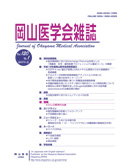

Journal of Okayama Medical Association
Published by Okayama Medical Association<Availability>
Full-text articles are available 3 years after publication.
Permalink : https://ousar.lib.okayama-u.ac.jp/18057
無カタラーゼ血液症に出現する高原氏病の成因についての実験的研究 第Ⅱ編 酸化酵素に対する過酸化水素の影響についての生化学的研究
竹久 亨
岡山大学医学部公衆衛生学教授
発行日
1968-02-28
抄録
With the purpose to know how is the effect of hydrogen peroxide on the succinic dehydrogenase system, experimental studies were conducted using duck, rabbit and mouse. The results obtained were as follows. I. In vivo study After injection of hydrogen peroxide in isotonic saline into the palate of ducks, having only a trace amount of catalase in their blood, inhibition of the activity of succinic dehydrogenase system was observed in the homogenate of their palate. Activity of succinic dehydrogenase system in the homogenate of palate of ducks, injected four times, decreased more markedly than that of duck injected ones. Ⅱ. In vitro Study 1) Activity of succinic dehydrogenase system in the homogenate of duck palate or mouse muscle, containing less amount of catalase, or in the mouse liver homogenate with addition of NaN(3), decreased more markedly than that of rabbit palate or mouse liver containing more amount of catalase. 2) Activity of succinic dehydrogenase system in the homogenate of the various tissues was decreased by addition of hydrogen peroxide. On the other hand, inhibited activity of succinic dehydrogenase system by hydrogen peroxide recovered as time lapses. From the above findings it is considered that the activity of succinic dehydrogenase system inhibited by hydrogen peroxide is reversible. Therefore, it seems that the causative factor of the gangrene in acatalasemia cases lies in the fact that so called respiratory enzyme group such as succinic dehydrogenase system in tissue cells, are disturbed by the accumulation of hydrogen peroxide produced from hydrogen peroxide generating micro organisms (hemolytic streptococcus, pneumococcus etc.)
ISSN
0030-1558
NCID
AN00032489
